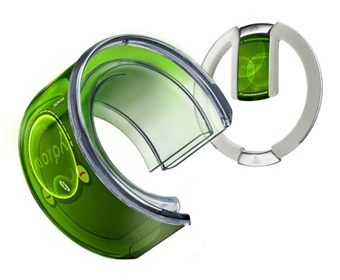Boffins at the Nokia Research Centre this week showed off futuristic gadget concepts they’ve been working on in the three years since initial launch of the Morph concept. Morph suggests that future mobile devices might be stretchable and flexible, allowing the user to transform the gadget into radically different shapes. Nanotechnology would enable the ultimate functionality delivering flexible materials, transparent electronics and self-cleaning surfaces.
September 29, 2010

Boffins at the Nokia Research Centre this week showed off futuristic gadget concepts they’ve been working on in the three years since initial launch of the Morph concept. Morph suggests that future mobile devices might be stretchable and flexible, allowing the user to transform the gadget into radically different shapes. Nanotechnology would enable the ultimate functionality delivering flexible materials, transparent electronics and self-cleaning surfaces.
The research centre, which operates in conjunction with Cambridge University in the UK, revealed four projects based on nanotech concepts that “might be integrated into devices within the next ten to 15 years.” Nokia believes these conceptual ideas could make mobile devices more intelligent and cost-effective, allowing them to interact with their environment in new and innovative ways.
Stretchable electronic skin
This demonstration shows how a stretchable, conformable substrate can be used as an elastic touchpad to offer new possibilities for future device form factors. It can not only stretch and conform to fit the human body, but the integrated touch and pressure sensors enable new user interface options. The stretchable electronic skin includes a thin (50 nanometres depth) evaporated gold film to act as a conductor which is embedded in the rubber. The gold film stretches with the skin and reverts back into its original shape, while continuing to remain conductive.
[youtube]http://www.youtube.com/watch?v=ZOJ2QSioTA0[/youtube] Dr Stéphanie Lacour, University of Cambridge Research Centre, talks about stretchable electronic skin
Nanowire sensing
By employing a network of nanoscale wires, a compact and potentially low cost “artificial nose” has been created which can accurately detect or “smell” different substances. The nanowires, which are fixed on top of the chip, effectively act as a chemical sensor and distinguish different substances which are placed close to the sensing surface. The nanowires inside the device then detect and identify trace amounts of contaminants in the environment.
When molecules from the substances stick to the nanowire surface, they cause a change in the electrical current flowing through the nanowire. The idea shows how nanotechnology can cheaply and effectively enable environmental sensing, such as the continuous monitoring and measuring of many things from air pollution, food-based contaminants to bio-chemical processes.
[youtube]http://www.youtube.com/watch?v=PAX_WYopkpE[/youtube] Jani Kivioja, research leader at Nokia Research Centre Cambridge, talks about a kind of “nano-nose”
Flexible printed supercaps
Compact, flexible supercapacitors enable the creation of significantly thinner capacitors than those in use today with significantly greater power. Current supercapacitors are 3-4mm thick but the flexible printed supercapacitor is less than 1mm.
Supercapacitors are used to deliver current bursts for device functions which require high power transients such as camera flash and audio/RF amplifiers. With a flexible printed circuitboard it would be possible to enable flash photography at much greater distances. Also the fact that the supecapacitor is fully flexible means it can be incorporated into a device in many different ways and the device design and form is not limited.
[youtube]http://www.youtube.com/watch?v=yfb0K-KKPjU[/youtube] Piers Andrew, Enabling Morph Team at Nokia Research Centre, Cambridge, talks about the super capacitor, which is.
Electroctactile Experience
Electrotactile experience enables users to feel different surface textures on the screen of an N900 which can correspond to an image or menu shown on the screen. For example if a rough surface like brick or sandpaper is displayed, the surface of the screen could be programmed to feel uneven.
The demo works by providing an alternating potential between the surface of device and the user’s finger when in contact with and sliding over the screen. This gives a tactile sensation known as electrovibration, which uses low voltages and does not stimulate the skin until it is moved across the surface of the screen. The N900 used for this demonstration had a modified touch screen and drive electronics but Nokia said this type of interaction could enable genuine 3D interaction.
About the Author(s)
You May Also Like







.png?width=300&auto=webp&quality=80&disable=upscale)

.png?width=300&auto=webp&quality=80&disable=upscale)

_1.jpg?width=300&auto=webp&quality=80&disable=upscale)


.png?width=800&auto=webp&quality=80&disable=upscale)